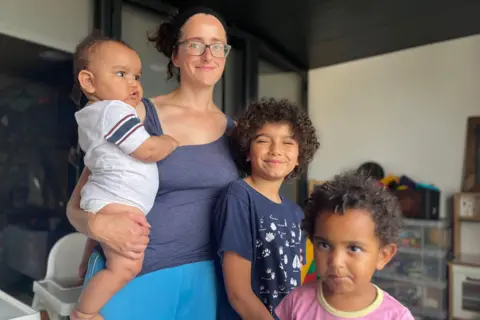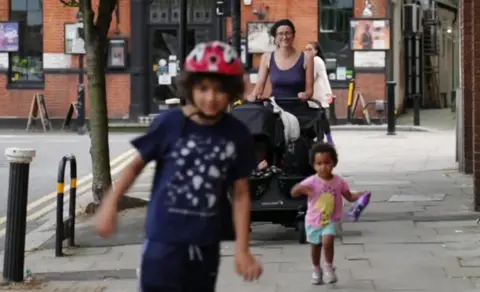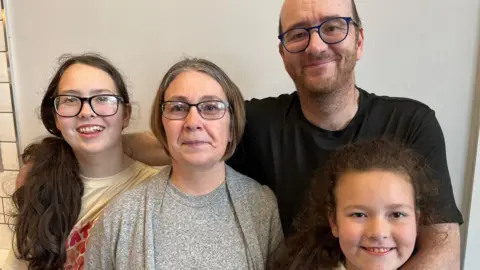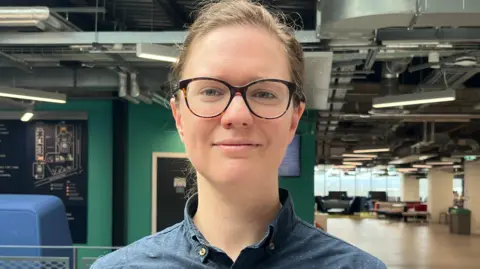 BBC
BBCThea and Kirsty both have three children, but contrasting policies on benefits in England and Scotland mean their lives are very different. After a Commons row about scrapping the two-child benefit cap, we meet the families affected.
In a one-bed flat in north London, Thea Jaffe is struggling to get her 10-month-old son Isaac to stay quiet.
Isaac is the main reason we’re here. He’s Thea’s third child, and as she relies on benefits to top up her salary, she doesn’t get Universal Credit or Child Tax Credits for him due to the two-child policy.
Introduced by the Conservatives, the policy means any third or subsequent child born to a family after April 2017 doesn’t get fully supported by the benefits system, only receiving the £16.95 a week child benefit payment.
Thea, a 38-year-old account development manager for a logistics company, knew that money would be tight when she unexpectedly became pregnant. She knew about the policy and did consider alternatives. But ultimately she decided to have Isaac.
“I couldn’t make this decision based on a government policy, because that could change in a heartbeat,” she says. “All it takes is one election and the environment is totally different. Do you really want to make decisions about your family based on something that’s so changeable?”

Over the course of the next hour or so, her other two children wander in and out. Nine-year-old Moses finished school earlier this week and needs some energy burning off; JJ, who is two, groggily walks into the living room following a nap.
Their rent has increased by £800 a month in the past two years, says Thea, as they had to move. The two-child policy means larger families miss out on around £3500 a year per child, and Thea’s £43,000 salary isn’t nearly enough to banish concerns about money.
A change of policy, as many MPs want, would mean “we would be able to buy milk on the way home instead of taking a detour to find the cheapest milk. We would be able to relax a little bit in our meal planning. And in turn, that [would] give me more head space to really help them with their homework and be there for them emotionally and just parent them the way I want to parent them.”
Thea Jaffe’s predicament goes to the heart of the problem the new government is facing on this issue.

The overt aim of the policy was “to ensure that families in receipt of benefits faced the same financial choices about having children as those supporting themselves solely in work,” according to then Chancellor George Osborne. The policy, ministers said at the time, would also encourage them to work more.
The policy does seem popular – a YouGov poll from last year suggested that 60% of the public supported keeping it.
Research however indicates that it hasn’t succeeded in achieving its goals. A paper from 2022 suggested that the policy had reduced the probability of an affected family having a third or subsequent child by just 5%. A report from the House of Commons Work and Pensions Select Committee concluded there was no evidence it increased employment among larger families.
Meanwhile, official government data shows it has increased child poverty among larger families, from 41% in 2016/17 to 46% in the latest figures.
The two-child policy affects 440,000 households, with 1.6m children between them. It affects families across the UK, but the impact of the policy has been somewhat reduced in Scotland due to the Scottish Child Payment.
Introduced by the Scottish government in 2021, it has since been extended and the value of the payment increased – it is now worth £26.70 a week and is payable for each child under 16 living in a low income household. Its currently received by 330,000 children. “It alleviates some of the pressure that you have from month to month,” says Kirsty Murray, a mother of three from Cumbernauld.

The 43-year-old works for a charity while her husband, Dougie, is a personal support worker for people with disabilities. Two of their three children – 16-year-old David and Rebekah, 12 – have additional needs, so the family’s total income of £25,000 is often stretched.
Next term they will also have to start paying for school meals for their youngest daughter, Mia, who’s 10. The Scottish Child Payment pays the family £213.60 every four weeks for their two daughters; David’s payment stopped when he turned 16.
“Life is stressful when you’ve two kids with additional needs,” says Kirsty. “It means we can do things like go out for a meal, go to the pictures, do whatever it is the kids want to do.”
She’s fully aware that she’s more fortunate than similar parents in England. “Is that fair? No. If the governments worked together and said, ‘Okay, what works in Scotland?’ Why can’t something similar be done in England.”
The Scottish Child Payment has broad cross-party political support. It cost £430m in the last financial year, paid for by higher tax rates in Scotland. Early evidence suggests it has slightly reduced the need for certain families to use foodbanks.
The Scottish government estimates that it will keep 60,000 children out of poverty this year, but child poverty levels in Scotland haven’t fallen since the policy was introduced.
“We know that inflation was very high for a few years and so costs were rising and households were facing a lot of pressure on their incomes,” says Hannah Randolph, an economist at Strathclyde University’s Fraser of Allander Institute. “So it’s possible the rate of child poverty would have been higher in the absence of the Scottish Child Payment.”

The Children’s Commissioner for Wales has called for the Welsh government to copy the Scottish Child Payment but there has been no similar suggestion from the new Labour government.
It insists that it can’t currently afford to scrap the two child limit, which would cost over £3bn. The prime minister says that tackling child poverty requires a rounded strategy that doesn’t just focus on one policy.
There is “no silver bullet” to dealing with the problem, Sir Keir Starmer told the Commons earlier this week. “It’s a complicated set of factors – to do with work, to do with housing, to do with education, to do with health. That’s why you need a strategy to deal with it.”
The last Labour government did cut child poverty. A government report in 2012 showed that the number of children living in relative poverty had decreased by 1.1m between 1998/99 and 2010/11, falling from 26% of children to 18%.
The Institute for Fiscal Studies think tank found that a key element in that change was an £18bn annual increase in spending on benefits for families with children.
According to Ruth Patrick, a professor of social policy at York University, reforming the welfare system is ultimately the key to tackling the problem.
“We do need to look at housing, work, childcare, early years and education. But the fundamental answer, driven by the evidence, is that we can’t address child poverty without investing in our social security system. It’s that simple.”

